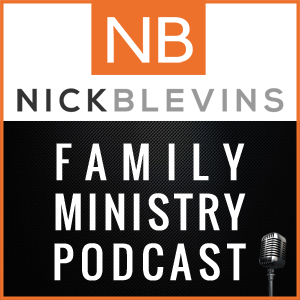Church growth barriers are commonly talked about in the local church and church leaders are always looking for how to overcome them. Usually however, we don't start looking until we have hit one and plateaued. In this post, I'll share my thoughts on the family ministry impact at each barrier. I'll also include the main thing Dan Reiland says is the issue at each barrier (from his Breakthrough Catalysts article). Finally, I'll include some thoughts from Tim Keller, found in his document Leadership and Church Size Dynamics, which is one of my favorite resources on the topic. Links to both articles are included below.
Notes on Church Growth Barriers
- They happen at typical church sizes but the exact sizes are different for every church.
- God grows the church and in my opinion, the barriers are natural times when our church needs to change in order for God to allow us to serve more people.
- A church may plateau or decline for other reasons. All we can do is be faithful with what we can do.
- Addressing every issue about a specific barrier may not be the magic bullet. However, it certainly helps.
The 100 Church Barrier
Dan Reiland's Focus: The Pastor
- Any church that's having a regular gathering needs children's ministry. Enlist a great volunteer to lead the ministry and the volunteers. Like the Pastor, the children's ministry leader should be a people-person who attracts others and helps them connect.
- Get a solid curriculum, like what Orange offers, to have great video components with a small group core. Provide that so leaders can focus on relationships and execution.
- Student ministry would be too much to handle here. A small group for students with 2 great leaders would be the most I would shoot for.
The 200 Church Barrier
Dan Reiland's Focus: Organization
- Children's ministry should be divided into preschool and elementary, with systems and processes being created for how to pull off both each weekend.
- Creating and documenting systems and processes allows you to bring on volunteers and give them responsibility and authority.
- Student ministry probably consists of small groups and probably does not need great organization but plans should be made to move to a more organized format.
- Somebody on staff (part-time) leading children's ministry would be typical here. They need to be get-it-done people who work through teams.
- Consider going to 2 services if you can create a critical mass feel at both. This allows children's ministry volunteers to serve and attend and creates a clear opportunity for new volunteers to step in. If you're in one service for too long, people may never want to split into 2 services and that insider focus could prevent church growth.
- Having 20-25 students would be typical here, and a great system would be a middle school group and a high school group, with events planned for both.
The 400 Church Barrier
Dan Reiland's Focus: Staff
- Children's ministry and student ministry staff must recruit, organize and equip volunteers as Dan describes in his article.
- Volunteers should have larger leadership roles and staff should primarily pour into them. Large group environments need to be well executed.
- Quality and organization really begin to matter here. Systems and processes should be outlined and documented for every ministry to help empower more volunteers.
- Assimilation begins to matter as well, as people can begin to get lost in the shuffle. Are you helping families get connected step by step?
- Student ministry could have a large group gathering here but don't start it unless you have the critical mass, volunteers, and can do it well. Use a solid curriculum designed for it, like XP3.
The 800 to 1000 Church Barrier
Dan Reiland's Focus: Vision
- Families should see a unified family ministry with a clear vision of what is offered for families and how families can partner with the church.
- Vision should be regularly cast to all volunteers. This is always important but as churches get to this size it is easy for vision to get lost or not communicated at every level.
- All staff must be great leaders to break through this barrier. The children's minister or student minister who is a great talent and is good at connecting with children or students may not be the right person from here on out. They need to be an excellent recruiter, coach, and leader of volunteers. They'll also need to be a leader of leaders, as they'll need strong volunteer leaders on their team to make things happen.
- Communication must be regular, consistent and in multiple formats. Both volunteers and families need communication they can rely on.
- The student ministry large group gatherings should function at a high level with small groups and serving opportunities happening as well.
The 1200 to 1500 Church Barrier
Dan Reiland's Focus: Communication
- All communicators/teachers in every large group environment should be gifted and strong.
- Communication with families about children's ministry and student ministry will happen through other avenues and it should be reliable, consistent and clear.
- Small group leaders should be the primary connection for parents since few of them would even know all of the staff in a church this size.
- All large group gathering events must be done really well with the clear result of helping people take steps in some way.
- Key staff must be leaders of leaders or the ministry they lead will be stuck.
- The family ministry should be unified with clear transitions between environments.
- Various events and groups should be in place to serve parents, marriages, and families in general.
The 2000 Church Barrier
Dan Reiland's Focus: Staff
- All family ministry staff should be leaders of leaders. A good system of leadership structure and development will help churches identify future staff from the volunteer base where people are already leading in a big way.
- For a while now, the church staff has been teams of teams. Team leaders must be excellent leaders and managers.
- Each ministry department with the family ministry operates like a church of 400 or 800 and the previous things apply.
- Children and student ministry teams have to be far more creative than before. Even when using a great curriculum, allowances have to be made when you have 400-500+ kids and 200+ students.
- If your church is multi-site you're working with churches of multiple sizes and dealing with different barriers while keeping everything unified.
Thoughts from Tim Keller's Article
- Tim states that two churches of completely different sizes may be more different than two similar-sized churches of different denominations. I agree.
- Every church has a size culture and often times we view other size cultures as bad. i.e., I can't know everyone (large church) or there aren't enough ministries (smaller church).
- Our staff discussed this article (and the other one) and we believe attenders could benefit from reading it if they had issues with our church that were directly related to a size culture. Most people want the benefits of multiple church sizes and none of the weaknesses. For instance, I want to know the pastor personally but have great family ministry environments for my kids.
- “The single best way to increase attendance is to add Sunday services.” Very interesting quote. Our church had 3 services at one point, went back to 2 balanced ones that held as many or more, but hit a growth stall until we added a 3rd service again. Tim is probably on to something here.
- “The small church ‘gets away' with amateurish quality because the key driving force is its intimacy, family-like warmth, and relationships.”
- “Up to the ‘800 barrier' churches can still get away with having a mediocre or poor small group system.”
- About the 800 barrier – “Staff members also must be increasingly gifted and able to not simply be ‘workers' nor even ‘leaders of workers' but ‘leaders of leaders.' They must not need lots of mentoring themselves and must be able to attract and supervise others.”
- “The larger the church, the more staff roles shift from “doing the job with guidance” to ‘making it happen'.”
- “The larger the church, then, the more important to raise and train leaders from within.”
- “Schaller says that the key to the very large church culture is trust.”
Church Growth Barrier Articles
A resource I highly recommend when it comes to breaking church growth barriers is Carey Nieuwhof's course, Breaking 200. Whether your church or your specific ministry (children's, students, groups, etc) is looking to break 200, it's a great option.
What barrier are you facing?






